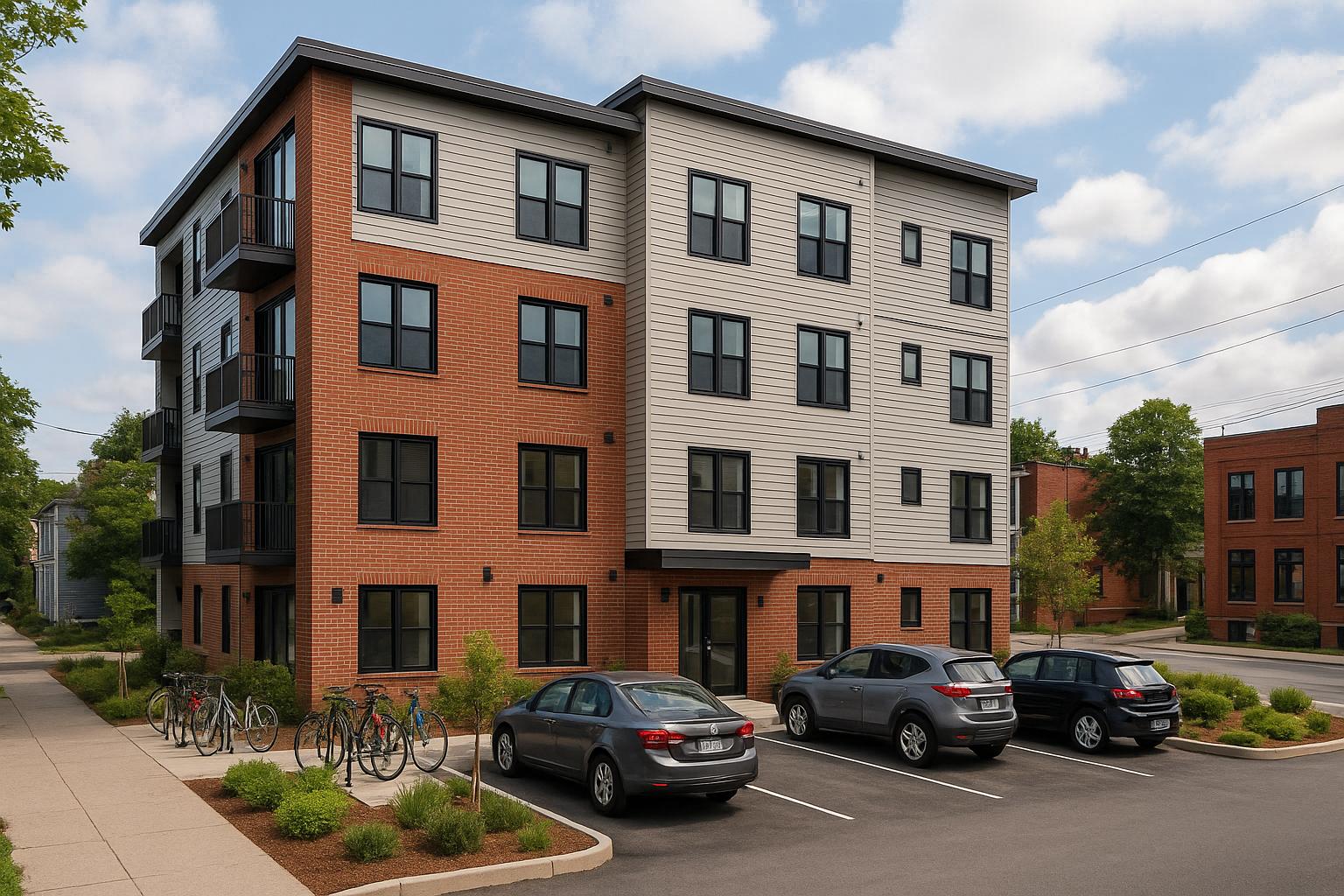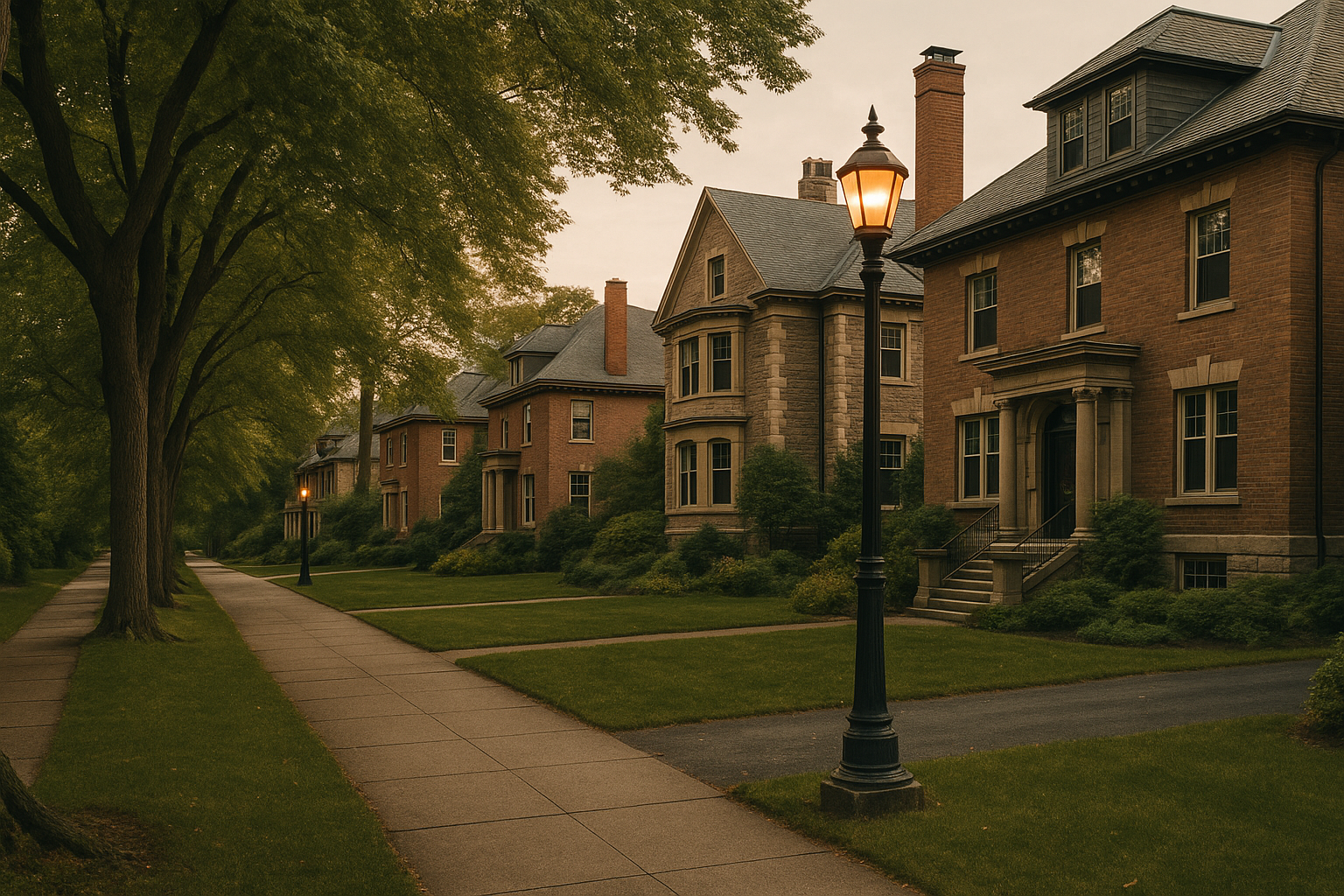Looking to invest in Halifax's rental market? Deciding between a duplex and a fourplex comes down to your budget, risk tolerance, and long-term goals. Here's the breakdown:
- Duplex: Lower upfront costs (~$420,000 to build) and simpler to manage. Rental income ranges from $3,900–$4,200/month. However, a vacant unit means a 50% income loss.
- Fourplex: Higher costs (~$640,000–$800,000 to build) but better economies of scale and risk distribution. Rental income is $7,800–$8,400/month, with only a 25% income loss if one unit is vacant. CMHC financing options (95% loan-to-value, 50-year amortization) can reduce carrying costs.
Quick Comparison: A duplex is more accessible for first-time investors, while a fourplex offers higher returns and stability. The choice depends on your capital and investment strategy.
Duplex Investment Breakdown: Costs, Income, and Tenant Demand
What Is a Duplex?
In Halifax Regional Municipality (HRM), a duplex refers to a two-unit residential property, typically around 2,400 square feet in size. Each unit comes with its own entrance, kitchen, bathroom, and living area, offering privacy for tenants. These properties are usually built on single lots zoned as R1, but turning them into duplexes often requires rezoning to R2 through Halifax Regional Council. This rezoning can open the door to higher rental income opportunities. Duplexes can be designed in two main layouts: side-by-side units or stacked vertically. Now, let’s break down the costs and financing details that make duplex investments in HRM an appealing option.
Construction Costs and Financing for Duplexes
Getting a handle on construction and financing is key to making a duplex investment work in HRM's active rental market. Building a duplex in the area typically starts at around $175 per square foot, which translates to approximately $420,000 for a 2,400 square foot property. Keep in mind, this estimate doesn’t include additional expenses like site preparation.
The permitting process is another important step. You’ll need both development and building permits from HRM, with fees determined by the value of your project. On top of that, budget for costs like surveys and professional services, as these can add up quickly.
When it comes to financing, lenders usually consider about 70–75% of the expected rental income for qualification purposes. For example, if you’re expecting $4,000 in monthly rent, around $3,000 of that could count toward your income qualification [1].
With these construction and financing basics in mind, let’s explore the income potential and tenant demand for duplexes in HRM.
Rental Income and Tenant Types
Rental income for duplexes in HRM depends on factors like location, unit size, and finishes. However, a common rule of thumb is that monthly rental income often equals about 1% of the property’s cost [1].
Halifax benefits from a broad tenant base, ensuring strong occupancy rates. A growing number of new residents in the area are under the age of 45, with noticeable increases in the 15–29 and 30–44 age brackets [2]. Halifax’s median age of 39.0 years [2] reflects a youthful and dynamic population. Many renters are drawn to duplexes because they offer a mix of home-like amenities - such as private entrances and small outdoor areas - along with the flexibility and convenience of renting. This combination helps keep vacancy rates low and turnover costs manageable.
Fourplex Investment Breakdown: Costs, Income, and Tenant Demand
What Is a Fourplex?
A fourplex is a residential property divided into four separate rental units, each with its own entrance, kitchen, bathroom, and living area. These units can be arranged in various layouts, such as side-by-side, stacked, or a mix of both. One of the perks of investing in a fourplex is that many fixed construction expenses - like foundations and roofing - are shared across all four units. This often leads to better cost efficiency per unit.
Let’s take a closer look at the construction costs and financing options that make fourplex investments attractive in the Halifax Regional Municipality (HRM).
Construction Costs and Financing Options
In HRM, the average construction cost for a fourplex is about $160,000 per unit, bringing the total cost for a four-unit building to approximately $640,000. Opting for an integrated design-build process can simplify coordination, prevent budget overruns, and ensure fixed pricing with predictable project timelines.
For those looking to meet CMHC MLI Select standards, the cost rises to around $200,000 per unit, or $800,000 in total. However, these projects are 40% more energy-efficient, which opens the door to financing options like 95% loan-to-value mortgages with just a 5% down payment and a 50-year amortization period. This structure significantly reduces monthly carrying costs and improves cash flow.
Rental Income and Tenant Types
Each unit in a fourplex in HRM can typically rent for between $1,950 and $2,100 per month. This means the entire property can generate a monthly income ranging from $7,800 to $8,400. Having multiple units not only increases overall rental income but also provides a safety net - if one unit becomes vacant, income from the other three units helps offset the loss.
Fourplexes appeal to renters who value the balance of private living spaces with the communal feel of a shared building, offering a home-like environment with added independence. This makes them a popular choice for a variety of tenant types.
Duplex vs Fourplex: Side-by-Side Financial Comparison
Financial Comparison Table
When weighing the choice between a duplex and a fourplex investment in HRM, the financial breakdown underscores key differences in scale and risk management. Here's a comparison based on standard construction costs:
| Investment Metric | Duplex | Fourplex |
|---|---|---|
| Construction Cost per Unit | $160,000 | $160,000 |
| Total Construction Cost | $320,000 | $640,000 |
| Monthly Rent per Unit | $1,950 – $2,100 | $1,950 – $2,100 |
| Total Monthly Income | $3,900 – $4,200 | $7,800 – $8,400 |
| Annual Gross Income | $46,800 – $50,400 | $93,600 – $100,800 |
| Vacancy Risk Impact | 50% income loss | 25% income loss |
| Estimated Annual ROI | 12% – 16% | 15% – 20% |
A duplex faces a steeper impact when a tenant moves out, with income dropping by 50%. In contrast, a fourplex only sees a 25% reduction in rental revenue if one unit is vacant. This makes the fourplex a more stable option for cash flow. These numbers also show how scaling up can lead to better returns.
Economies of Scale and ROI Analysis
Looking beyond the table, fourplex investments often outperform duplexes because of cost efficiencies and better risk distribution. For instance, construction costs like foundation work, roofing, and site preparation are spread across more units in a fourplex, reducing the per-unit expense and boosting overall returns.
Using a streamlined design-build approach can amplify these benefits. This method cuts down on waste and shortens construction timelines. On average, this approach saves $47,000 in unnecessary expenses and reduces project completion from the usual 12–18 months to just six months. Yuan He, co-founder and CTO of Helio, highlights this advantage:
"Our scheduling system prevents the delays that eliminated our initial project."
Completing a project in six months instead of over a year means less time without rental income, which can significantly improve profitability.
Another advantage of a fourplex investment is the CMHC MLI Select financing option. While this financing increases construction costs to $200,000 per unit (totalling $800,000 for a fourplex), it offers 95% financing with just a 5% down payment - approximately $40,000 upfront. The 50-year amortization period keeps monthly carrying costs low, allowing the property to potentially generate positive cash flow from day one, despite the higher initial investment.
For investors with limited capital, this financing model offers a significant opportunity. With leverage ratios reaching up to 20:1 (compared to the usual 5:1), the potential for higher rental income and returns makes fourplex investments an appealing alternative to duplexes.
sbb-itb-16b8a48
Construction Challenges and Solutions
Problems with Fragmented Construction
Managing multi-unit construction projects in HRM can quickly become overwhelming for property owners. The main issue lies in the lack of coordination when dealing with a host of independent professionals - architects, engineers, general contractors, electricians, plumbers, and other trades - all working on their own timelines.
This fragmented system often leads to serious headaches. Budgets can balloon by 30–60% due to cost overruns. For instance, when trades clash over scheduling or responsibilities, delays and extra expenses pile up, often without anyone taking responsibility. Timelines, which might start at eight months, can stretch to 18 months as each trade waits for the previous one to finish. On top of that, the permitting process - riddled with missing documents, repeated plan revisions, and municipal red tape - can further drag things out. Without a single point of accountability, property owners are left juggling every detail themselves. These challenges highlight the need for a more streamlined and unified construction method.
How Integrated Design-Build Works
An integrated design-build system offers a solution by simplifying and consolidating the entire process. Instead of the traditional piecemeal approach, this model unites all professionals under one team, eliminating coordination issues and providing a single point of accountability. From planning and permitting to construction, everything is managed seamlessly.
Helio Urban Development in Nova Scotia demonstrates how this approach works. They address budget concerns with fixed-price contracts, ensuring costs are locked in once the project scope is defined. As Helio explains:
"At Helio Urban Development, we offer fixed pricing to help you avoid budget shocks. Under a fixed-price contract, the construction costs are locked in once the scope is defined, which lenders love because it reduces surprises." [3]
This fixed pricing eliminates the uncertainty that often plagues traditional projects, giving property owners clear financial expectations before construction begins. The integrated team also takes charge of the permitting process, handling everything from preparing building plans to working with municipal offices:
"Permitting can be daunting. We'll prep the building plans, handle the submission, and coordinate with municipal offices until you have your official permits in hand - no nightmares over missing documents!" [3]
By combining fixed pricing and synchronized scheduling, the design-build method significantly reduces timelines. Projects that might take 12–18 months under traditional methods can be completed in just six months, allowing property owners to start earning rental income sooner. For a property generating $7,800–$8,400 in monthly rent, finishing six months earlier could mean an additional $46,800–$50,400 in the first year alone.
With this model, accountability is centralized. One team oversees every aspect of the project, eliminating finger-pointing when challenges arise. This single-point responsibility also improves quality control, as potential issues are addressed early in the design phase, avoiding costly changes later. The result is a more efficient process that saves time, controls costs, and boosts ROI.
For property owners deciding between duplexes and fourplexes in HRM, the construction method is just as critical as the type of building. While fragmented construction can derail budgets and schedules, an integrated design-build approach ensures your project is completed on time, within budget, and to the standard needed to meet your investment goals.
The Truth About Illegal Multi-Family Rental Buildings in Halifax, Nova Scotia
Which Investment Makes More Sense for You?
After breaking down the financials and construction methods, the final decision ultimately depends on how these align with your personal investment strategy.
Key Factors to Consider
Choosing between a duplex and a fourplex comes down to factors like your available capital, comfort with risk, and long-term goals. Duplexes generally require less upfront investment, making them more accessible, while fourplexes offer better cost efficiency thanks to options like CMHC MLI Select financing.
Risk is another big consideration. With a duplex, losing one tenant means a 50% drop in rental income. On the other hand, a fourplex spreads out the risk - if one unit is vacant, you're only losing 25% of your income. That said, fourplexes come with the added responsibility of managing more units, which can be more time-consuming.
Your investment timeline also plays a role. If you're focused on long-term wealth building, the higher cash flow and potential for greater returns with a fourplex might be appealing. But if you're looking for a simpler, lower-maintenance option with a shorter horizon, a duplex could be a better match.
Once you've weighed these factors, the next step is finding the right construction partner to bring your project to life and protect your return on investment (ROI).
Choosing the Right Construction Partner
The right construction partner can make or break your project. Opting for a team that uses an integrated design-build approach can help you stay on budget, stick to timelines, and avoid the headaches of juggling multiple contractors.
Fixed-price construction is a game-changer for keeping your finances predictable. By locking in costs once the project scope is finalized, you eliminate budget uncertainty. This approach not only protects your ROI but also reassures lenders. As Helio Urban Development explains:
"At Helio Urban Development, we offer fixed pricing to help you avoid budget shocks. Under a fixed-price contract, the construction costs are locked in once the scope is defined, which lenders love because it reduces surprises." [3]
An integrated team also simplifies the permitting process. They handle everything - from drafting building plans to submitting them to municipal offices - so you don’t have to worry about red tape:
"Permitting can be daunting. We'll prep the building plans, handle the submission, and coordinate with municipal offices until you have your official permits in hand - no nightmares over missing documents!" [3]
When issues arise, having one accountable team ensures faster resolutions and clearer communication compared to managing multiple independent contractors.
Whether you decide on a duplex or a fourplex, working with a builder who offers fixed pricing, guaranteed timelines, and seamless project management will help you maximize your returns and avoid unnecessary construction stress.
FAQs
What are the key risks and benefits of investing in a duplex versus a fourplex in Halifax's rental market?
Investing in a duplex or a fourplex in Halifax's rental market offers its own set of challenges and rewards, depending on your financial goals and available resources. Both options can provide rental income and tax perks, but they also require a bigger initial investment and more hands-on management compared to single-family homes.
A duplex is often a practical option for first-time investors. It’s typically more affordable, and you can live in one unit while renting out the other to help cover your mortgage. That said, losing a tenant can cut your rental income by as much as 50%, which can be a tough financial blow.
A fourplex, on the other hand, offers the potential for higher income and greater stability. If one tenant moves out, your rental income only drops by 25%, which is less of a hit. However, this option comes with a heftier upfront cost and demands more active management. It’s often better suited for experienced investors or those who can hire professional property managers.
Deciding between a duplex and a fourplex comes down to your budget, the time you can dedicate to managing the property, and your long-term investment plans.
What are the benefits of using an integrated design-build approach for constructing multi-unit properties in HRM?
An integrated design-build approach streamlines the process of constructing multi-unit properties by bringing the design and construction phases under one unified team. This fosters close collaboration among architects, engineers, and builders, cutting down on miscommunication and potential project delays.
By tackling potential challenges early on, this method supports quicker project timelines, more precise cost estimates, and fewer surprise expenses. It removes the disconnect often experienced with traditional methods, giving property owners a more efficient and predictable construction journey.
What are the financing options for building a fourplex in HRM, and how do they affect long-term profitability?
Investors in Halifax Regional Municipality (HRM) have several ways to finance the construction of a fourplex. Common options include construction loans, private lenders, and investment groups. Another appealing choice is CMHC-insured mortgages, which come with perks like up to 95% financing, a 50-year amortization period, and lower interest rates. These features can significantly reduce upfront expenses and improve cash flow.
Although CMHC-insured financing might slightly increase the cost per unit, the combination of higher leverage and reduced borrowing rates often leads to stronger long-term returns. Taking the time to carefully assess these financing options can help ensure your strategy aligns with your investment goals and boosts profitability over time.



